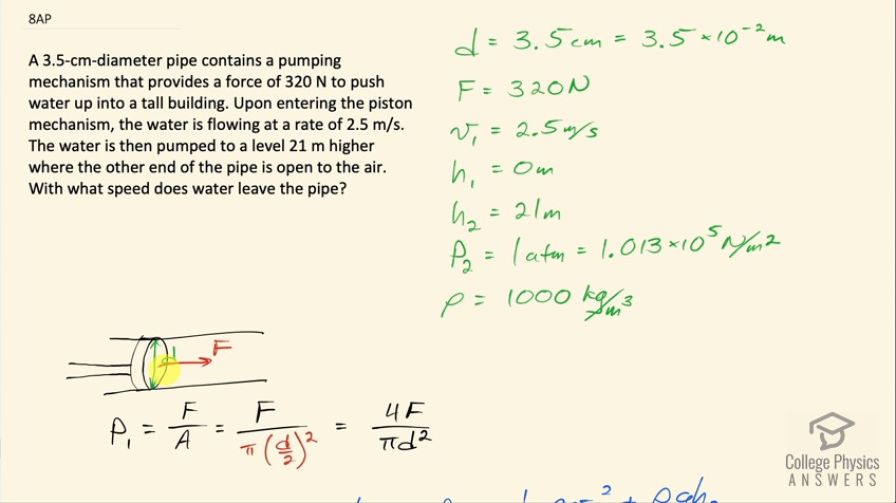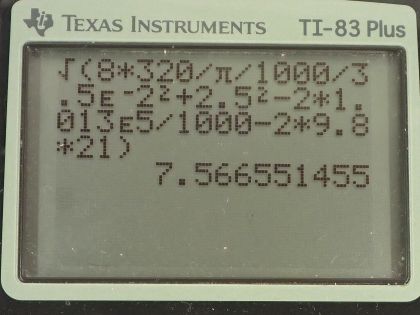Question
A 3.5-cm-diameter pipe contains a pumping mechanism that provides a force of 320 N to push water up into a tall building. Upon entering the piston mechanism, the water is flowing at a rate of 2.5 m/s. The water is then pumped to a level 21 m higher where the other end of the pipe is open to the air. With what speed does water leave the pipe?
Final Answer
Solution video
OpenStax College Physics for AP® Courses, Chapter 12, Problem 8 (Test Prep for AP® Courses)

vote with a rating of
votes with an average rating of
.
Calculator Screenshots
Video Transcript
This is College Physics Answers with Shaun Dychko. A pipe with a diameter of 3.5 centimeters, which is 3.5 times 10 to the minus 2 meters has a piston in it which is applying a force of 320 newtons to some water that appears here and the water gets here with a speed initially of 2.5 meters per second and we'll call this height number one at 0 meters— we'll say this is the reference level— and then it's going to go up the pipe to a height h 2 of 21 meters and the pipe at this position up here is exposed to the atmosphere and so pressure at position two is 1 atmosphere and then density of water is 1000 kilograms per cubic meter and we are going to fill in all the terms here in our Bernoulli's equation starting with figuring out how to calculate pressure one. And so we know what the diameter of this piston is and we assume that it's cylindrical and so it has a area of π times its radius squared and the radius being half the diameter and the pressure then is force divided by that area so that's 4 times the force divided by π times diameter squared and we multiply top and bottom of this by 4 and it cancels with this 2 squared, which turns into 4 there. Okay! So that gets plugged in for pressure one here. And then we add to this one-half times the density of the water times its initial speed at this piston position squared plus ρgh 1 but h 1 is 0 so this term is 0. Pressure two is atmospheric pressure and the fluid will have some speed one-half times the density of water times v 2 squared and our job is to figure out what v 2 is and add to this the potential energy per unit volume term, ρgh 2. Okay! So we will subtract atmospheric pressure from both sides then also subtract potential energy term from both sides and we are left with one-half ρv 2 squared is 4F over πd squared plus one-half ρv 1 squared minus P atmosphere minus ρgh 2 and then multiply both sides by 2 over density and then we get this line here and then we can square root both sides to solve for v 2. So v 2 then is the square root of all of this: 8 times the force divided by π times density times diameter squared plus v 1 squared minus 2 times atmospheric pressure divided by density minus 2gh 2. So the factor 2 here comes from multiplying all these terms by 2 and then we are dividing each of these terms by ρ. Okay! Then we plug in numbers so v 2 then is the square root of 8 times the force of 320 newtons divided by π times the density—1000 kilograms per cubic meter— times the diameter of 3.5 times 10 to minus 2 meters squared plus 2.5 meters per second squared— that's the initial speed at the piston position— minus 2 times atmospheric pressure, which is 1.013 times 10 to the 5 newtons per square meter divided by 1000 kilograms per cubic meter minus 2 times acceleration due to gravity times the height of position two, which is 21 meters and this works out to a speed of 7.6 meters per second.
